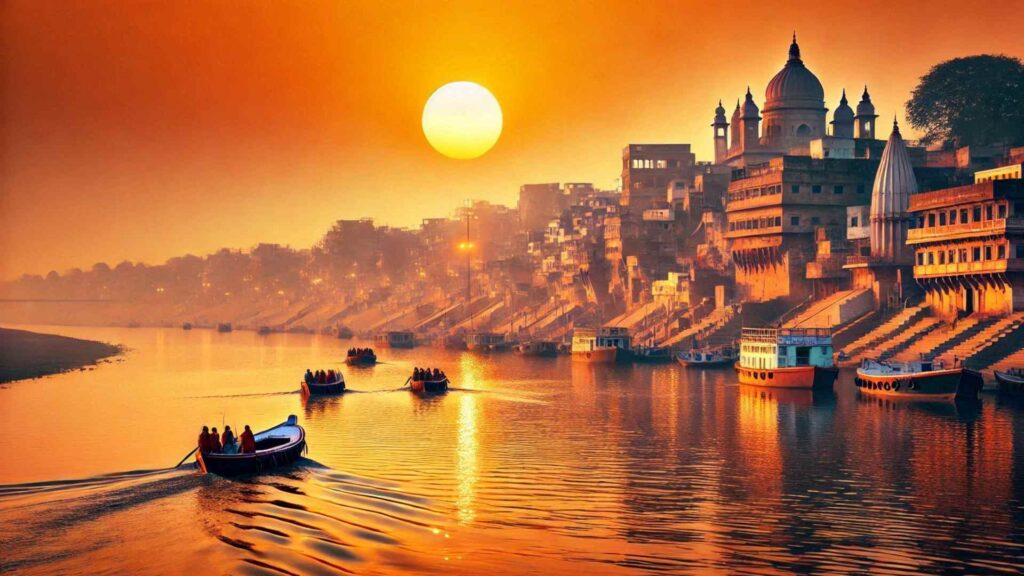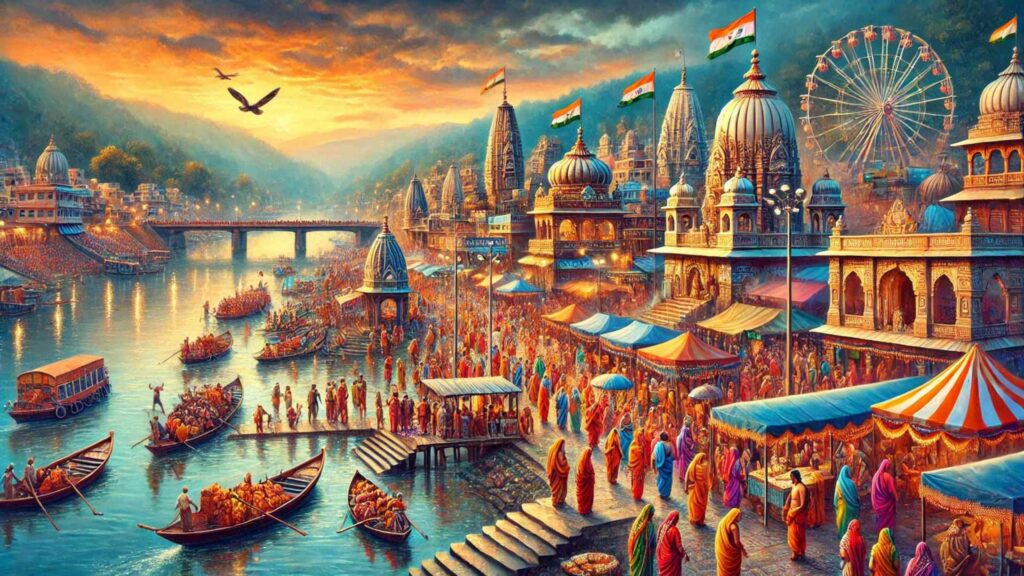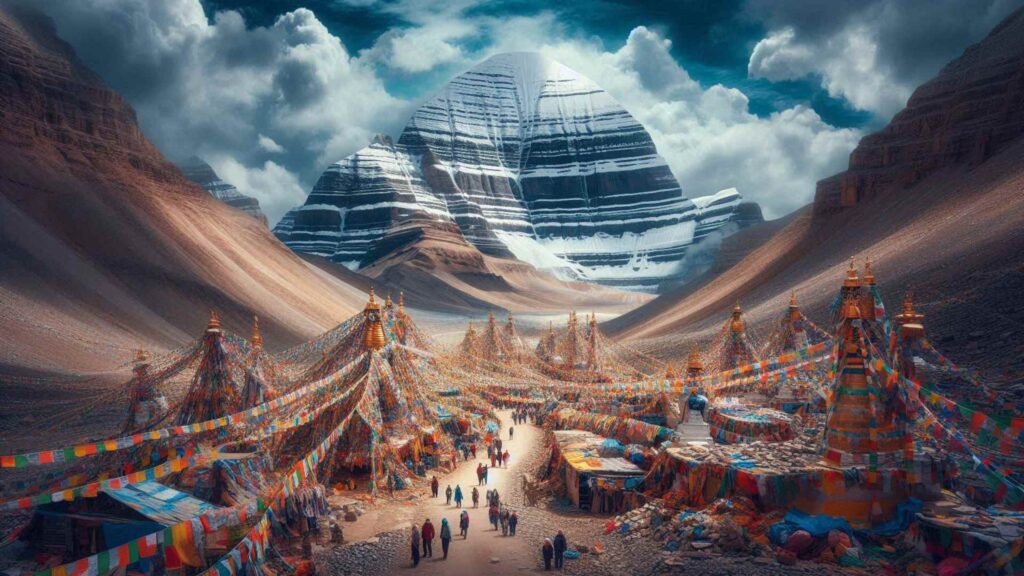Hindu Traditions and Sacred Elements: Rivers, Cities, Mountains, and More
Imagine the gentle flow of the Ganges, the sound of temple bells, or the serene majesty of Mount Kailash. Hinduism’s sacred elements are not just places or natural features but symbols of divinity deeply interwoven into its traditions. These elements—rivers, cities, mountains, forests, and temples—are more than physical entities; they are manifestations of spiritual philosophy and cultural identity.
Read More About sacred texts
Hinduism’s concept of sacredness arises from its belief in the divine’s omnipresence. Rivers like the Ganges are revered as life-giving mothers, sacred cities like Varanasi are seen as gateways to liberation, and temples serve as sanctuaries of divine energy. Together, these elements form a holistic system that connects individuals with the cosmos.
In today’s fast-paced world, these traditions and sacred elements offer timeless lessons on devotion, environmental stewardship, and cultural preservation, making them as relevant today as they were millennia ago.
1. Historical Background
Holy Rivers: Mythological Origins

- Ganges: The Ganges descended from the heavens when Lord Shiva captured its immense flow in his locks to save the earth. The river is celebrated in texts like the Rig Veda and Mahabharata.
- Yamuna: Linked to Lord Krishna’s playful childhood, the Yamuna is revered for its role in the epics.
- Saraswati: Once a mighty river, Saraswati is now considered a spiritual river, often associated with wisdom and learning.
- Narmada: Believed to have emerged from Shiva’s sweat, the Narmada is venerated for its purifying properties.
- Godavari: Associated with Sage Gautama and Lord Rama, it is called the “Ganga of the South.”
Sacred Cities

- Varanasi: Known as Kashi, it is one of the oldest cities in the world and a hub of spiritual practices.
- Haridwar: A key site of the Kumbh Mela, Haridwar is where the Ganges enters the plains.
- Rishikesh: Renowned for yoga and meditation, it has attracted sages and seekers for centuries.
- Mathura and Ayodhya: Birthplaces of Lord Krishna and Lord Rama, respectively, these cities are central to Hindu mythology.
Mount Kailash and Sacred Forests

Mount Kailash, considered the abode of Lord Shiva, is regarded as the axis mundi (cosmic axis) in Hindu cosmology. Sacred forests and groves, often associated with goddess worship, have been sanctuaries for ecological and spiritual practices since ancient times.
Temples and Ashrams
From the simple Vedic shrines to grand temples like Meenakshi Temple and Jagannath Temple, Hindu temples evolved as centers of devotion, learning, and community activities. Ashrams have served as spaces for meditation and spiritual instruction.
2. Spiritual Significance
Religious Importance
- Rivers: They are considered divine mothers, purifiers, and life-givers. Bathing in them is believed to cleanse sins and bestow blessings.
- Cities: Sacred cities are seen as spiritual power centers where the divine and mortal worlds converge.
- Mountains and Forests: Symbolize spiritual ascent, ecological harmony, and divine presence.
- Temples: Serve as sanctuaries of divine energy, connecting devotees to deities.
Symbolic Meaning
- Ganges: Represents purity, continuity, and liberation.
- Mount Kailash: Stands for spiritual stillness and the ultimate goal of union with the divine.
- Sacred Groves: Reflect the interconnectedness of nature and divinity.
- Temples: Embody the cosmos and serve as portals to the divine.
Connection to Deities
- Rivers are often personified as goddesses, such as Ganga and Yamuna.
- Mount Kailash is revered as Lord Shiva’s abode, embodying his meditative energy.
- Temples house the physical representations of deities, making them focal points for rituals and devotion.
Energy and Spiritual Properties
Pilgrimages to these sacred sites are considered transformative, cleansing karmic debts and recharging spiritual energies. Rituals performed in temples and sacred spaces amplify divine vibrations.
Role in Hindu Philosophy
Hinduism views these elements as extensions of the divine, emphasizing harmony between the sacred and mundane. They remind devotees of the impermanence of life and the eternal nature of the soul.
3. Practical Application
In Worship
- Rivers: Used for ritual bathing, offerings, and immersion of ashes.
- Mount Kailash: Circumambulation (parikrama) is a highly revered spiritual practice.
- Temples: Centers for daily worship, special rituals, and celebrations.
- Sacred Forests: Locations for meditation, yajnas (fire rituals), and goddess worship.
Daily Practices
- Chanting mantras dedicated to river deities or temple deities.
- Performing yoga and meditation in sacred spaces like Rishikesh.
- Offering prayers and flowers at home shrines inspired by temples.
Rituals and Ceremonies
- Ganga Aarti: A daily evening ritual at river ghats.
- Shivaratri: Observed at Mount Kailash and Shiva temples.
- Kumbh Mela: A mass pilgrimage involving ritual bathing in sacred rivers.
Modern Adaptations
- Virtual temple tours and live-streamed rituals.
- Eco-friendly practices in offerings and ceremonies to protect sacred rivers and forests.
Home Worship Incorporation
Sacred water from rivers, miniature temple replicas, and idols enable devotees to integrate these elements into their daily rituals.
4. Cultural Impact
Influence on Society
- Rivers like the Ganges sustain agriculture and livelihoods.
- Sacred cities are hubs of religious tourism and cultural activities.
- Temples provide social services such as education and charity.
Art and Literature
- Sacred rivers and temples inspire classical music, dance, and painting.
- Epics like the Mahabharata celebrate the Ganges and cities like Ayodhya.
- Temples like Khajuraho showcase intricate artistry rooted in devotion.
Festival Connections
- Diwali: Celebrated in Ayodhya to honor Lord Rama’s return.
- Kumbh Mela: The largest religious gathering on Earth, held along sacred rivers.
- Yoga Festivals: Celebrated in Rishikesh, highlighting its spiritual heritage.
Regional Customs
Rituals like immersing idols in rivers and preserving sacred groves reflect regional variations in Hindu worship.
Contemporary Relevance
These sacred elements inspire ecological consciousness and spiritual introspection, reminding humanity of its responsibilities toward nature and the divine.
5. Conservation/Preservation
Current Challenges
- Pollution of sacred rivers like the Ganges and Yamuna.
- Urban encroachment on sacred groves and cities.
- Neglect of temple heritage due to modernization.
Preservation Efforts
- Namami Gange: A government initiative to clean and protect the Ganges.
- Reforestation projects to restore sacred groves.
- Temple trusts and NGOs working on restoration and awareness campaigns.
Environmental Aspects
Hinduism emphasizes reverence for nature, encouraging sustainable practices such as planting trees during festivals and reducing pollution.
Community Initiatives
- Clean-up drives organized by local groups.
- Awareness programs on the importance of preserving sacred sites.
- Promotion of eco-friendly rituals.
6. Expert Insights
Quotes from Religious Scholars
- “The Ganges is the soul of India, offering spiritual and physical sustenance.” – Swami Vivekananda.
- “Mount Kailash represents the ultimate union of man and cosmos.” – Sadhguru.
Scientific Research
- Studies highlight the self-purifying properties of Ganga water.
- Research on sacred groves underscores their ecological significance.
Modern Interpretations
Spiritual leaders emphasize the relevance of sacred elements in addressing contemporary challenges like climate change and mental well-being.
Expert Opinions
Conservationists and scholars agree that preserving these elements is essential for maintaining their cultural, spiritual, and environmental significance.
7. Conclusion
The sacred elements of Hinduism—rivers, cities, mountains, forests, and temples—are not just physical places but spiritual symbols. They connect devotees with the divine, inspire cultural and artistic expression, and remind humanity of its responsibility toward nature and the cosmos.
Which sacred element resonates with you most? Share your reflections and join the conversation!


